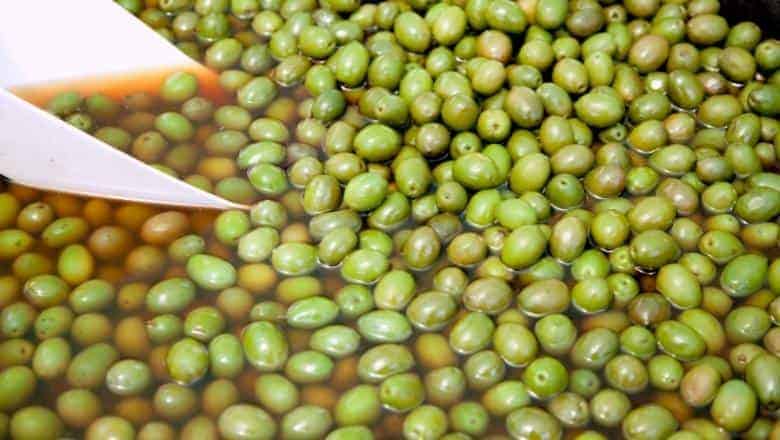Olives Are Too Salty? Here’s How To Fix It!
Olive Knowledge is a part of Amazon Associates. As an Amazon Associate, we earn from qualifying purchases. Read our Affiliate Disclosure to learn more.
No doubt, brined olives are a fantastic addon to many meals, especially the ones that originate from Mediterranean countries. However, sometimes they tend to be too salty, and not everyone likes that. Today, I’ll show you a little trick that I learned, and it’s about desalting olives so they’re easily edible.
Key Takeaways:
- To make olives less salty, separate the brine from the olives, put olives into a bowl, pour it with cold water, stir, and try after an hour.
- If they’re still too salty, replace the water and repeat the process once more.
- Once you’re satisfied with the saltiness, return the olives to the jar, and pour back the brine.
Why Are Brined Olives Salty?

First things first, I want to talk about why olives are salty. I’ll be short, so you don’t wait too long for the tutorial.
Olives aren’t usually salty when you harvest them from the tree, they taste bittery. However, to prevent spoilage of olives, they must be placed in brine. This brine will also help to remove their bitter taste.
Salt is one of the oldest techniques to preserve foods, and actually, it’s one of the best ways since it’s a completely natural process. Most olive brines are made with salty water, and of course, olives soak that salt and become salty – which is mostly good, but not everyone prefers that.
Related: Are Olives Still Good To Eat If They Have White Spots
Olives are an extremely healthy fruit that everyone should eat, but if they’re too salty, it may be a problem for people with some diseases such as high blood pressure. That’s why it’s good to know the way of desalting them.
Now that you know the basics, let’s see how you can desalt brined olives.
How To Desalt Brined Olives: THE GUIDE

I’ll write you a short step-by-step guide so that you can easily follow this and make your olives less salty.
1. Drain The Brine
To begin the process, you should first drain the brine from the jar. I like to put it into a separate jar and keep it for later (I’ll tell you why in a minute).
The brine is what makes olives salty in the first place, and we should separate it from the fruit.
If you want, you can drain the brine into the sink, but make sure to read the whole guide before that, because you might need it again.
2. Put Olives In a Bowl With Water
Now that all the olives are brine-free, you should put them in a bowl that’s half full of water. Make sure that water is cold, don’t use warm water since it can ruin the olives.
Stir the olives a little, and let them soak in the water for approx. 1 hour. After one hour, you can try one olive and check if you like it, or it’s still too salty.
If olives are good for you, you can continue to the next step. However, if you feel like olives are still too salty, you should replace the water in the bowl, and repeat the process. You can repeat this process as many times as you want until the olives taste good for you. Mostly, 2-3 times will be enough.
3. Put Olives Back To The Jar
When you’re happy with the olives’ taste, drain that water from the bowl (do it thoroughly), and return the olives back to the jar.
If you’ll eat all of those olives the same day, you can even keep them in the fridge for a few hours, nothing bad will happen. But if you plan on storing them in the fridge for a longer time, you should protect them from spoilage – by pouring a brine into the jar again.
4. Fill The Jar With a Brine or Olive Oil
As I already told you, to preserve olives, you should fill the jar with brine again. You can use the old brine (that’s why I told you to keep it in the 1st step), or you can use olive oil, which will also preserve them.
Using a brine will again increase the saltiness of olives a little bit, but it won’t be near close as it was before. Personally, this is the way I like to do it. That way, I keep the taste as close as it was before the desalting process. Just use the brine and fill the jar in it, the brine should cover all the olives.
Using olive oil to fill the jar is a great way if you want to have a completely salt-free taste of olives. They’ll be perfectly fine in the olive oil. For this, you don’t have to use the most expensive olive oils such as extra virgin olive oil. Some cheaper olive oil from the local market will be completely fine. That way you won’t spend a lot of money on desalting olives.
Whichever of these methods you use, you’ll probably be satisfied. If you want olives to taste similar to when you bought them (but less salty), use brine. You can even make a new brine yourself.
On the other hand, if you want olives to taste slightly bitter and with olive oil aromas, fill the jar with olive oil. It’s all up to you, both methods work seamlessly.
Keep The Jar Properly Stored
When you’re done with everything, you should then store the jar properly. That way, olives will last longer and you’ll have more time to enjoy their taste, before buying a new jar.
If you have olives in brine, you should keep them in the fridge. That’s the best way for storing them. On the other hand, if you poured olive oil into a jar of olives, the best thing you can do is to store it in a way olive oil should be stored – in a dark and cold place (but not the fridge).
